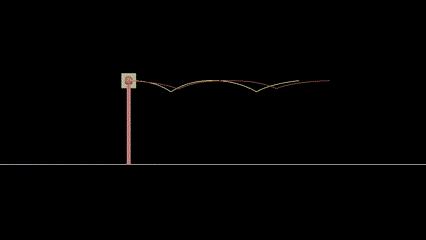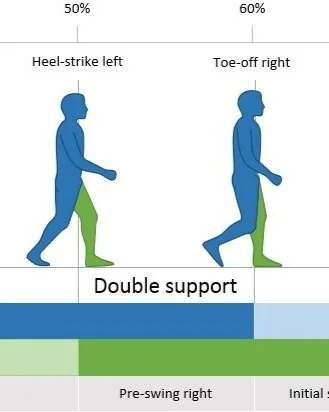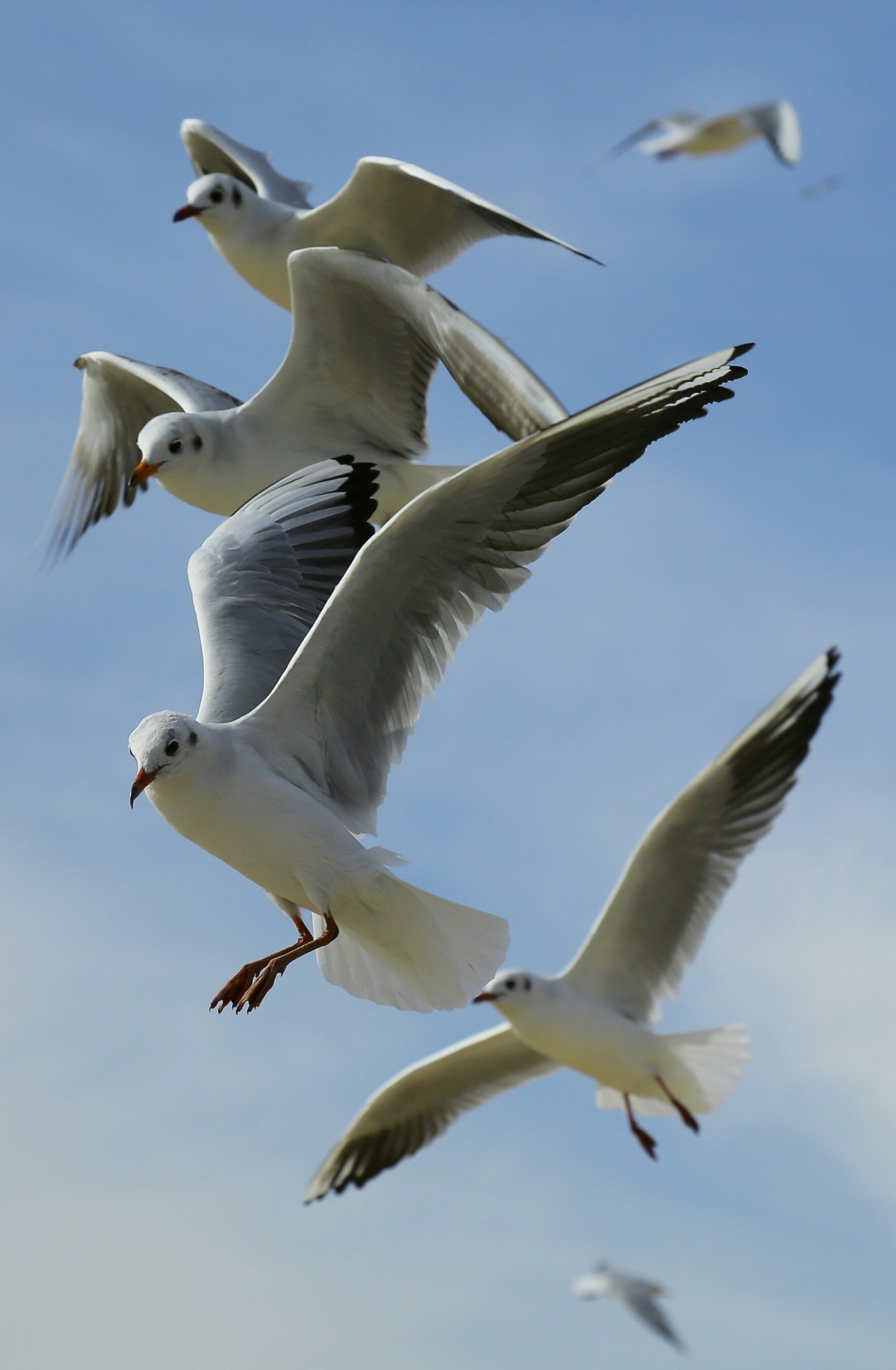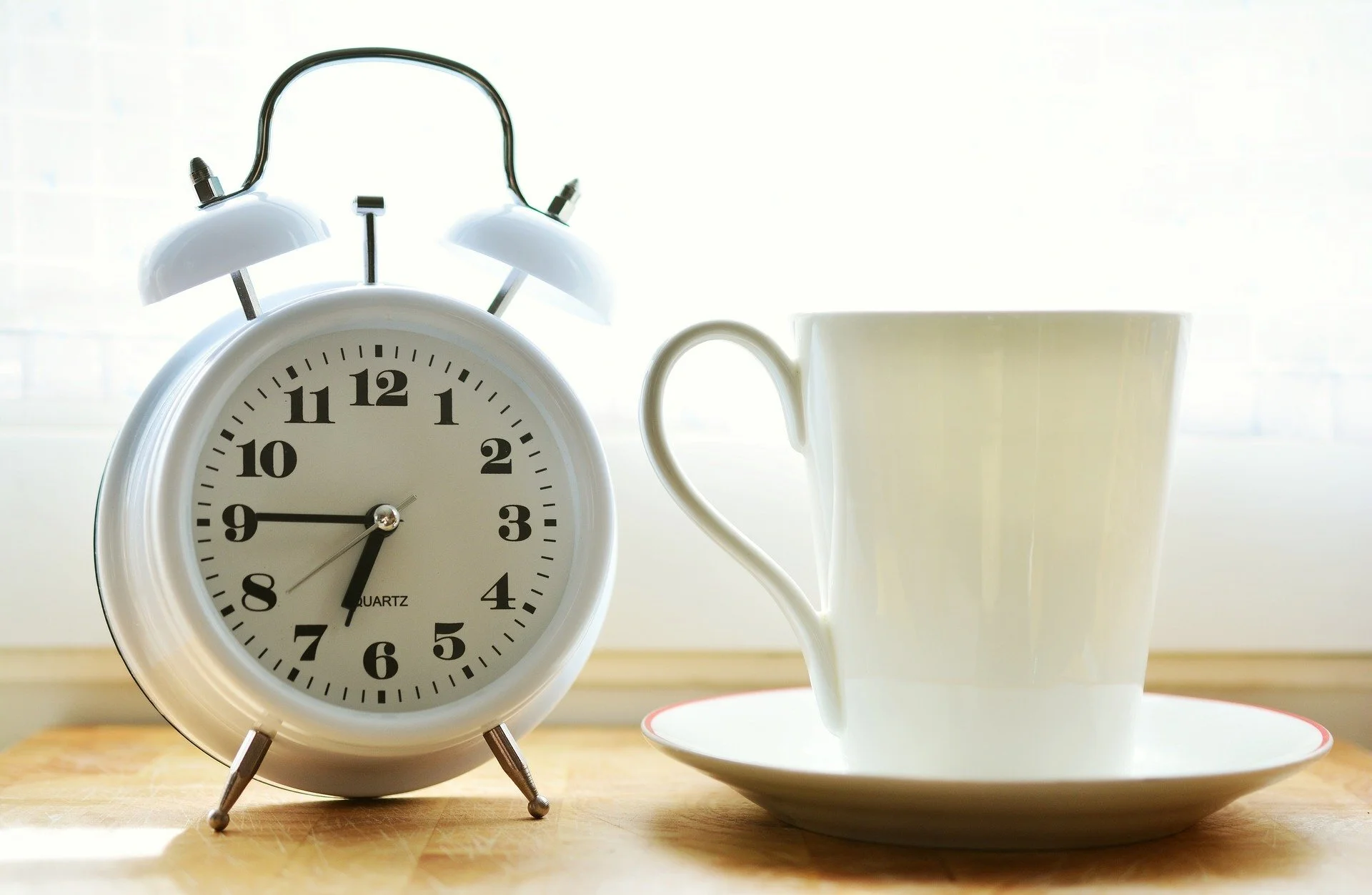THE MOVING BODY - Walking Gait Analysis for Animation (Part I)
INTRODUCTION
Waking is THE human mode of transportation, brought by our upright posture. To the naked eye, it is often overlooked despite its complexity and significance. What may seem like a simple act of moving one foot in front of the other involves intricate movements and coordinated efforts by various body parts. The anatomy of walking has a lot of layers to it, depending on what you are looking for. If you zoom in from looking at just the right and left feet moving, you can start seeing all kinds of action that go along with it: arm swings, feet lifting, hips turning, knees bending and straightening…
If you want to have an even closer look at it, you'll realize just how much goes into a single step, how each body part pushes and pulls on the rest of the body rhythmically, how a part contracts and some relaxes with specific timings to make the motion seem smooth; how the lower extremities act and react to the floor and the outside world to maintain balance and momentum. Every element plays a crucial role in propelling us forward while conserving energy.
Efficiency is key in a healthy walk cycle, with propulsion and energy conservation being the primary objectives.
At its core, walking involves coordinating numerous muscles, joints, and bones working in harmony.
But it's not just about the legs; the entire body is involved in the process. The spine provides stability and support, while the arms swing in sync with the legs to maintain balance and momentum.
As I mentioned, the walking cycle has a lot of layers and complexity, so to avoid getting overwhelmed, we will break it down into its most basic components. First, we will break it down temporarily into small chunks and actions. Second, we will break it down physically to understand all the components and movement patterns that go into a step.
But before we do all of that, we will look at the gait cycle from afar, cover some general knowledge about human walking, and understand the few forces that are actually pushing our body forward.
Physical changes from bipedalism
Between 3 and 6 million years ago (there is still some debate on the date), certain species of early humans stood upright and started taking the first steps.
Even if it's pretty established that our upright stance and walking go hand in hand, exactly why we adopted this upright stance is not entirely certain. What we can observe though, is that a full upright posture is not necessary for bipedalism. Walking isn't strictly human, chimpanzees sporadically walk on two legs, but for them, it is always for a limited duration and never for long distances. If you've ever seen one do it, you'll probably understand why. They are not built for walking on two legs. Firstly, because they usually use their arms to walk, they are very top-heavy. With the center of mass being higher it makes it difficult to balance. Second, their knee cannot extend fully, having them constantly walk in a squat position.
What an upright stance is necessary for in walking is during long distances. Walking just becomes a lot easier then, and here's why: with an upright posture everything is stacked on top of each other, requiring a lot less energy to just "stand".
Some big changes happened in our physiology because of walking, with the main ones listed here:
Instead of a "C" curve, our spine was straightened up, creating the "S" curve that defines it. The S curve of the spine alone (though there are also some other features that we will get into later) helps with shock absorption, acting like a small spring.
Since our head drastically changed angle, the spinal attachment to the skull was moved from the back of the head to the bottom.
The hip bone got wider and shorter, with some important muscle shifting from the back of the hip to the side. They help us stabilize our position and balance better.
Our leg bones got longer, and with them our stride length.
The knees moved from spreading to the side to being centered and are able to extend fully. Shifting the knees to the center aligns the body mass with the rest of the skeleton. Fully extending the knee makes it a lot easier to stay upright for longer without relying fully on the muscles.
Our feet got longer and the thumb moved towards the center axis. Longer feet also helped us take longer strides. The bottom of the foot got arched rather than being flat to help absorb the weight of the body.
Freeing our ribcage from the weight of the body made us able to better control our breathing, possibly leading us to talk.
Stats and goals of a Modern Walk Cycle
Often the gait cycle is analyzed only on one side, with the understanding that the opposite side, at least in a healthy individual, will simply be mirrored, and that's how we are gonna present it from now on.
Let's start by breaking down the gait cycle into its biggest components and talking about some of the major statistics.
Walking is the repetition of the gait cycle, which is what we consider in common terms the sum of a left and right step.
For each leg, the gait is divided into two phases, stance and swing. We define the stance phase as the foot being on the ground, while during the swing phase, the foot is off the ground and moving forward. In a standard gate, close to 60% of the time is spent on the stance phase and 40% on the swing phase.
Talking about time, one full stride takes on average one second to complete. The average walking speed is 4.5 km/h (or 3 mph). This is important because our cities' infrastructure is often built with this average in mind. Think about the countdown of green light in a crossing, the design and size of pedestrian spaces, and planning the distance between different points of interest (ex. How far apart the metro accesses and bus stops are).
To be a useful mode of transportation, there are two major goals that a healthy walk cycle needs to meet: propulsion, as in the ability to move the body forward; and energy conservation (being able to move efficiently as to use the least amount of energy possible).
Inside the walk, some of the secondary objectives of the body are shock absorption (being able to sustain the falling weight of the body on foot contact), and stance stability (holding up the weight on only one leg while the other advances forward). But we'll cover these last two more in detail in the next article.
In short, the main goal of the walk is to move as smoothly as possible forward while conserving the most amount of energy. The key word is efficiency.
What pushes us forward
Action is created by force that is generated using energy. In the case of vertebrates, these physical actions come from the force of muscle contraction pulling on a system of levers (joints and bones, click here for more details) that create motion.
Most of the human's basic movements are the combination of the force we can produce with our bodies through muscle contraction while at the same time taking advantage of naturally occurring forces from around us. In most cases, that force is gravity.
At any point in the walk, multiple forces act on the body. You've probably heard that walking is a series of controlled falls, so let's see what that means.
Taking the first step
We generally start our walks from a standing position. From there, we start tipping our body forward, disrupting the balance we had on our two feet. While leaning forward gravity starts acting on the body pulling our hips and center of gravity down, and our body starts falling. You can picture this first part as a tree trunk or a domino piece falling.
Falling lets gravity accelerate our body down and forward, which is half of what we are trying to achieve. This part is mostly passive. The next step is to stop our fall to the ground by putting our legs in front to catch ourselves. This begins the active phase where we use muscle contraction to resist falling, while we keep our forward momentum. In the same movement, as the leg passes behind us, we keep contracting our muscles to push our foot backward and into the ground, pushing our body up.
(Technically our muscles don't directly push ourselves forward. Our leg and its muscle contraction are trying to shove the ground down, but since the ground is often stable and impossible to move, the result of that reaction is that our body moves up instead.)
This active part of the walk uses muscle contraction to neutralize the force of gravity, bringing our center of gravity upward past its normal height so that we can fall again. Gravity and muscles are constantly battling and canceling each other's vertical forces, while our leaning forward makes sure that we constantly advance. Conceptually, you can think about the walk as a rolling egg.
The rest of walking functions by advancing one leg forward and pushing the ground backward in alternation. While one is pushing and supporting the weight the other one is advancing.
BREAKDOWN OF THE GAIT CYCLE
Having covered the conceptual layers of a walk we can go through the cycle again to break it down from simple to complex. We'll start adding piece by piece, joint by joint so we can better appreciate how each component influences the trajectory of the hip and its efficiency in locomotion.
LEG SWING
Let's start by simplifying the lower part of the body.
The most intuitive part and one of the most important parts of the walk is the leg swing. The leg is reaching forward while the opposite leg pushes the body ahead. Without anything else to soften the steps, the weight of the falling body will create a strong shock compression on the whole system, especially the spine.
HIP TWIST
As the hip starts getting involved, things get more interesting. We can find the combination of the two major rotations on the hip. The first is on the horizontal plane. As the hips swing back and forth, it increases the reach of the leg significantly. By outsourcing some of the reach from the legs, these don't need to stretch as far anymore, making it so the hip itself naturally drops less. With each reduction of the arc of the main center of mass, we become more efficient and walking requires less energy, while at the same time reducing the stress of the weight of the fall on the whole body. The second rotation at the hip is lateral and happens as we lift our feet, but it makes more sense to cover it in the next step.
Following the red trail compared to the previous yellow one, you can see the reduction in the up and down motion of the hip and the extra reach we get at the end of each step.
KNEE FLEXION
The task the knee performs changes depending on which part of the cycle we analyze it. At the first contact position, the fully extended knee provides extra reach forward. As we come in contact with the ground and transfer the weight on the forward leg, bending the knee, much like a spring, provides some much-needed shock absorption. At this point, it reaches the full peak of its angle. In the passing position, the knee maintains a small degree of flexion, allowing the hip to maintain a lower position. Which again reduces the up-and-down motion and lets the hip move in a straight line. As the supporting leg moves backward, the knee keeps extending until it reaches again full extension backward just before lifting the foot. With the foot finally detaching from the ground, the knee bends again, raising the foot, and helping it clear any small obstacle that could be found on the ground during its forward reaching. It is during this advancement of the limb that the lateral rotation of the hip comes into play. The hip naturally drops on the side of the bent leg while tilting upward on the side of the support leg. This twist adds another layer of smoothness to the hip by helping its center hold a more horizontal trajectory.
Following the red trail compared to the previous yellow one, you can see the reduction in the up and down motion of the hip and the extra reach we get at the end of each step.
As we start walking forward, the angle of our legs rotates inwards - our feet come closer to a center line underneath our bodies. During the walk, at each step, the weight needs to be supported on only one leg for a certain period. This weight support requires the hip to translate side to side and we lean the center of mass closer to the leg that is supporting the weight. If the legs didn't join together nearing the center, the weight shift would be substantial. By inclining the legs nearer the center of mass we markedly reduce the left/right swing of the body and make it a lot more efficient.
This is what the weight shift would look like if we didn’t bend the legs inward:
And this is what the weight shift looks like while pulling the legs towards the center:
THE FOOT
The foot is the base of support for the walk and the ankle/foot arch provides the first layer of shock absorption on ground contact. During the step, the weight on the foot is transferred from the heel to the toes, with the big toe being the last point of contact during the leg raise. The axis of the foot makes it so the roll is not fully straight but diagonal. At contact, the foot is slightly tilted externally, and as we walk forward the weight is slowly shifted to the inside and front.
During the advancement of the leg, the ankle is slightly flexed to clear the ground and any possible obstacle in the way.
The natural axis of the digits of the foot support the transition of the weight during the walk from back-external to front-internal.
Marking the weight progression’s area on the foot during one step
THE UPPER BODY
The lower body is responsible for most of the work of walking, while the upper body acts like the passenger. While the upper body is not directly engaged in creating movement, it also contributes by adding stability. On each rotation of the hip and swing of the leg, the upper torso and spine rotate contralaterally. This subtle but necessary movement neutralizes the momentum that would have otherwise been created by the rhythmic rotation of the hips. This, in turn, also helps maintain the body moving in a straight line.
The same motion also happens one layer above the body, as the head keeps focusing the gaze forward toward our destination.
The arms cadence follows the opposite swing of the legs.
There has been for a long time the question of whether the characteristic swinging of the arms during the walk was a passive or active movement. As for my current understanding, arm swinging uses around 12% less energy than not swinging the arms, meaning the swing is more likely not muscle-driven, but happens passively. The momentum creating the arm swing most likely comes from the compensatory rotation of the chest.
Passive arm swing seems to be mostly a feature of slow walks though, as on higher walking speeds and bigger step lengths the contribution of active muscle work increases to match the amplitude and rhythm of the swinging legs.
KEY MOMENTS AND MOVEMENT PATTERNS
So far we've covered the major swings and motions of the body without going into too much detail on any specific part.
In the next section, we'll do something slightly different and freeze up time by taking some snapshots of the key moments in walking. We'll cover some of the basic positions in more detail that you can use as a reference, and to prepare some groundwork for the future part 2 of this article.
Please note that while the reference is a "standard" walk, these positions can change a lot between people depending on age, flexibility or lack thereof, energy levels at any given moment, walking speed, weight, muscle fitness and strength, and so on…
CONTACT POSE
The moment of first contact between the front heel and the ground. The leg is generally straight and the ankle is flexed forming a 90° angle. The swing of the opposite arm accompanies it.
LOADING RESPONSE
It marks the moment when the weight is transferred to the front foot. It's the moment the foot reaches a fully flat position on the floor. Generally, the lower part of the leg is perpendicular to the ground. The hip in this pose has the highest flexion - hip flexion describes the thighs lifting closer to the chest. So at this point of highest flexion, the hip and the knee are getting closer to each other in level. The hip is also at its lowest position in the movement arc - it drops slightly as the body "falls" forward.
PASSING POSITION
HEEL OFF
In the passing position of the foot holding the weight of the body, the body is slightly leaning to the side of the weight-holding foot. Hips and chest are parallel (with regards to the left-right swing rotation) in this position. The hip and knee generally retain a slight bend. It marks the end moment of the foot being flat on the floor.
The leg is now in the opposite position of the contact pose. The heel, knee, and hip are in full extension backward. The hip is rotated backward on the same side while the chest is rotated in the opposite angle. The same side arm swings forward. The weight of the body is positioned in the middle at this moment while shifting to the opposite leg.
TOE OFF
Matches the loading response on the opposite foot. At this moment the final toe is detaching from the ground leaving only the opposite leg supporting the weight of the body. The hip and ankle remain in extension while the knee bends to start lifting the foot.
MID SWING
This matches the passing position on the opposite foot. Chest and hip rotation are aligned forward while both arms keep on the side. The hip is flexed (meaning the thigh comes upwards), together with the knee and ankle to help the foot clear the ground underneath.
TERMINAL SWING
The leg is swinging forward. At this moment the upper leg has reached the final position, and the lower part of the leg will maintain momentum to reach full extension and cycle back to the contact pose. The hip is at the highest position on its arc at this moment.
In short, the division of each step in the walk cycle will look something like this:
Finally, to conclude this first part, here are some of the movement patterns of the major body parts that you can use for reference.
Tracking on a stationary cycle
Tracking on a moving cycle
Videos used as reference for this article:
NEXT…
In part one, we had a general overview of what makes a walk cycle without going into too much detail. We looked at some of the major forces that are at play during the walk, and we’ve built the walk by adding one layer of complexity at a time. We’ve looked at walking from three different angles: the forces that create movement, the single segments of the walk and what each one of them contributes to make walking more efficient, and the key moments that make the walk.
Now that we have a better overview of walking, we can go more in detail in part two and look at the muscles involved on each part of the walk, and the challenges we need to overcome at each step to make a walk successful.
YOU MAY ALSO ENJOY:
In this little series of posts, I want to simplify and make the topic of anatomy accessible. My focus will be mostly on understanding the biomechanics of movement. We'll focus on the joints and muscles that make us move.
Bibliography and references
Perry, Jaquelin. Gait Analysis - Normal and Pathological Function.
Rose, Jessica. Gamble, James G. Human Walking.
Palastanga, Nigel. Field, Derek. Soames, Roger. Anatomy and Human Movement.
Vaughan, Christopher L. Davis, Brian L. O’connor, Jeremy C. Dynamics of Human Gait.
Ferber, Reed. Macdonald, Shari. Running Mechanics and Gait Analysis.
Yegian, Andrew K. The Role of Muscles in Arm Swing and Thoracic Rotation During Walking
Desilva, Jeremy. First Steps: How Upright Walking Made Us Human.
Earls, James. Born to Walk.
Arm swing in human locomotion
https://en.wikipedia.org/wiki/Arm_swing_in_human_locomotion
Biomechanics Lecture 11: Gait
https://www.youtube.com/watch?v=QB0tJajDvMw&list=PLS-ocxImwSG_VODKg-Ow12FsyGfDC9cnz&index=11
Observational Gait Analysis - Lecture 1
https://www.youtube.com/watch?v=WsnWnvH3PrM&list=PLwSMRX38xS9AVhulUENkZLCraUn3GM6x3
Observational Gait Analysis - Case Study Review
https://youtu.be/USEtXSRkfAU?list=PLwSMRX38xS9AVhulUENkZLCraUn3GM6x3
THE PHASES OF WALKING (GAIT CYCLE BREAKDOWN)
https://youtu.be/QAnEhz6Eqn4?list=PLwSMRX38xS9AVhulUENkZLCraUn3GM6x3
Phases of the Gait Cycle 1
https://youtu.be/JM0EwSlvR1c?list=PLwSMRX38xS9AVhulUENkZLCraUn3GM6x3
Explaining the Gait Cycle for the NPTE
https://youtu.be/dvpi1WHCDwM?list=PLwSMRX38xS9AVhulUENkZLCraUn3GM6x3
Ground Reaction Force During the Gait Cycle
https://youtu.be/Y2RHvicAM2o?list=PLwSMRX38xS9AVhulUENkZLCraUn3GM6x3
Analysis of Gait Motion Frontal Plane
https://youtu.be/SV0dQnimzrg?list=PLwSMRX38xS9AVhulUENkZLCraUn3GM6x3
Analysis of Gait Motion: Transverse Plane
https://youtu.be/H4wXKqmJac4?list=PLwSMRX38xS9AVhulUENkZLCraUn3GM6x3
The Gait Cycle [Part 1] | Initial Contact (IC) → Midstance (MSt)
https://youtu.be/88juEC9vVyE?list=PLwSMRX38xS9AVhulUENkZLCraUn3GM6x3
The Gait Cycle [Part 2] | Terminal Stance (TSt) → Pre-swing (PSw)
https://youtu.be/6eLbHGJhZvA?list=PLwSMRX38xS9AVhulUENkZLCraUn3GM6x3
The Gait Cycle [Part 3] | Initial Swing (ISw) → Terminal Swing (TSw)
https://youtu.be/BI08Ij8-tNA
Analysis of Gait Motion: Sagittal Plane
https://youtu.be/uh7riepyJl4?list=PLwSMRX38xS9AVhulUENkZLCraUn3GM6x3
Athletic Male Standard Walk - Realtime. Animation Reference Body Mechanics
https://youtu.be/GBkJY86tZRE?list=PLwSMRX38xS9AVhulUENkZLCraUn3GM6x3
The Gait Cycle
https://youtu.be/-G3EFtkq3qI?list=PLwSMRX38xS9AVhulUENkZLCraUn3GM6x3
Walking Gait Analysis, In Sagital, Frontal and Transverse plane ||Gait Biomechanics
https://youtu.be/OcLFMHTyrnw?list=PLwSMRX38xS9AVhulUENkZLCraUn3GM6x3
Athletic Male Standard Walk. Animation Reference Body Mechanics
https://youtu.be/vq9A5FD8G5w
Human skeletal changes due to bipedalism
https://en.wikipedia.org/wiki/Human_skeletal_changes_due_to_bipedalism
Step by Step: Evolution of Bipedalism
https://efossils.org/book/step-step-evolution-bipedalism
Pictures:
Walk cycle: Wikipedia
https://commons.wikimedia.org/wiki/File:Walk_cycle.jpg
Bones of the foot: Wikipedia
https://upload.wikimedia.org/wikipedia/commons/5/52/812_Bones_of_the_Foot.jpg
Woman Walking on Pathway Under The Sun
https://www.pexels.com/photo/woman-walking-on-pathway-under-the-sun-3779751/
Great ape skeletons in the Museum of Zoology, University of Cambridge
https://commons.wikimedia.org/wiki/File:Great_ape_skeletons_in_the_Museum_of_Zoology,_University_of_Cambridge.jpg
Comparative anatomy skeleton
https://commons.wikimedia.org/wiki/File:Figure_29_07_02ab.jpg
https://www.photojoiner.net/ for the photo edit
https://www.draw.io/ for the diagram



















































In this post, we will try to take those basics and go more in-depth, looking at the gait from a slightly more functional and anatomical angle. We will cover the main muscle groups, timings, and bone structures responsible for moving us forward and answer the question: What makes a walking gait successful?